An In-Depth Look at the Bob Dylan Center's Unheard Live Recordings
Talking Supper Club, Salt Lake '76, and more with co-curator Parker Fishel
Flagging Down the Double E’s is an email newsletter exploring Bob Dylan shows of yesteryear. Some installments are free, some for paid subscribers only. Sign up here:
I was lucky enough to spend the past weekend at the grand opening of the Bob Dylan Center in Tulsa, Oklahoma. The Center is terrific, a museum that, even while it would be accessible to the casual fan, offers plenty for the superfan to salivate over. One example among many: Even after I’d probably spent five or six hours there over two days, I suddenly stumbled upon a never-heard World Gone Wrong outtake, “I’ve Always Been a Rambler,” tucked away on a wall. It sounded amazing (time for an early ‘90s Bootleg Series?), and that sort of revelation is everywhere you look.
But the public-facing Center is only the tip of the iceberg (speaking of icebergs, you can also see handwritten early lyrics for “Tempest”). Everything that’s on display still only represents a tiny fraction of the full Dylan archives in Tulsa. So I wanted to learn what else they have.
Not the untold lyric sheets and studio sessions and photos and ephemera, though I’m curious about that too. Since this newsletter focuses on Dylan in concert, I wanted to get more information about their stash of rare and never-heard audio and video recordings of shows, and how fans can hear it.
So I sat down with Parker Fishel, Archivist and Co-Curator of the Bob Dylan Center, to dive deep. No matter how esoteric and specific my questions — and, fair warning, some of them are pretty esoteric and specific — he was a wealth of knowledge.
Again, I am only focusing on live material here, so if you’re looking for more of a broad overview of the Center and archives, I’d check out recent articles in the New York Times and Vanity Fair.
Okay, here’s my conversation with Parker, slightly edited and condensed.
Every article I’ve read has like one or two sentences about how you have all this unseen or unheard concert stuff, but I haven't seen much detail. So, to start, can you just give an overview or what you actually have there?
Sure. I'm trying to think how to break it up because there's the stuff that came from Dylan, then there's the stuff that came from acquisitions after the fact.
What came from Bob? Let’s start there.
With Bob's stuff, the first live recording would be Town Hall in April of ’63, then Carnegie Hall in October. Columbia Records was trying to do a live album that was then shelved in the aftermath of the assassination of John F. Kennedy.
If you start there, it's a lot of stuff. The live recordings that were generated from within Dylan's world really pick up with the '66 stuff. The soundboard recordings that Richard Alderson made.
I've interviewed him. He made some of the Village recordings, too.
In fact, I helped him to find some that he put in the care of a gentleman when he left the country for Mexico in '71 or '72. It had just sat since that time.
Oh yeah, he told me they were lost. He gave it to a friend and the friend flaked on him or something.
I sent a Hail Mary through some archivists' listservs. It turned up at the New York Public Library. It was in an unprocessed collection, so they were quite pleased to find out that they had rare Dylan mixed in there. And even just beyond Dylan, all the free jazz stuff that he engineered, the stuff with Belafonte.
So Richard made those unbelievable recordings, which again, are all available now. Then the '74 tour was also recorded.
All of the shows?
Not all of the shows.
The other caveat here is over time, things do have a way of disappearing, being incomplete. Either because when they were created, they were incomplete—like when they were doing Before the Flood, they were doing A reels and B reels and they might miss something. The whole point was to not miss anything, but accidents happen. So there are gaps. But most of that tour was recorded. There's the two-inch multi-tracks that are the concerts that became Before the Flood. Then there's a set of reel-to-reel recordings, quarter-inch reel recordings, and then audio cassettes.
Then there's all the Rolling Thunder stuff.
Is that basically the same stuff that they released on the box set? Whatever it was, four shows, five shows.
Yeah, yeah. There might be more that are incomplete shows that are out there, but I think that's pretty much the whole of the thing.
1976 there's, again, most if not all of the tour was recorded, with certain things being missing for one reason or another.
Does your set include the fabled Salt Lake City?
No. We ran that down. What Joel Bernstein told me was that the cassettes [they were recording on] were integrated into the rig they had. They could just pop in a cassette and record the show. But they'd sent all their equipment home by Salt Lake City. They were using borrowed equipment, and it didn't have the same sort of setup. That was not recorded.
If you guys can't find it, it probably is truly lost.
You know, I give it up for like a guy like Bill Pagel. He'll probably be the one to pull it out. That's why he's part of the Center. I think one of the strokes of genius is to find the collectors whose hearts have always been in the right place. To bring them into the fold and allow them to track down things. In effect, that's how the acquisitions that came after the fact, a lot of those came through Bill Pagel, Mitch Blank, Jeff Friedman.
I saw some of the cool videos downstairs are labeled “the Bill Pagel collection.”
They built these relationships of trust over years and years and years. When there was this official place for these recordings to end up, they'd already sort of primed the pump that these are historically important. Yes they're valuable, but they also need to be part of this larger story. It's been good having them as allies on our side.
Of the stuff the Dylan crew sent, do you have more recent stuff like a Never-Ending Tour? Are they taping all that stuff?
Yes, I think the stuff that's currently in the archive goes up to 2016, when the archive was acquired, but the Dylan office does continue to collect that stuff. The Center and the archive has a good relationship with them, so I think it is the hope and the desire that that material does someday fill out the story.
Presumably, taping from the soundboard is easier technologically these days. Do you have like every show in 2016 or 2010 or whatever?
Yes. I would say generally every tour is very well represented from 1966 onwards with the exception of maybe 1988-1996 where coverage is more sparse. Major events like Supper Club are there, but there's less soundboard recordings. Otherwise everything from 1997 onwards is pretty complete.
The thing that would be interesting is that there are rehearsals. Before they go on tour, they will take a week to rehearse. If you’re someone who wants to sit and listen to rehearsals, I think they’re quite interesting.
I've interviewed a lot of the musicians and it always surprised me. You think of Bob as, like, spontaneous or flying by the seat of his pants. You don't think of him as somebody who's drilling the musicians for a week before every tour—even though they probably just toured two months prior.
Yeah, but then you hear those bands and you're like, "I get it." They can do so much and so well.
This is maybe a dumb question, but do you know why they tape the rehearsals? Are they listening back?
I imagine it's on the chance that someone in the band—
If Bob says, "Were you taping that?”, you don't want your answer to be no.
No, you don't. You want to have it on hand, and it's better to have it than to not have it. That's my total guess.
Do you have any personal favorite things you’ve heard on rehearsal tapes?
There's some lovely rehearsal performances from Rundown [in the gospel era] that appear to have been pulled for copyright purposes. One is a solo performance of “Baby Give It Up” and another is a duet with Regina McCrary (then Havis) on an early version of “Ain't No Man Righteous, No Not One.”
Also as you can imagine, there are incredible covers throughout. Three examples:
1. The Jumpin' Bill Carlisle song “No Help Wanted” from rehearsals with Tom Petty and the Heartbreakers in December 1985
2. A really grooving “Folsom Prison Blues” from an August 1998 rehearsal in Melbourne
3. A 2014 soundcheck with the band running through a beautiful arrangement the Lefty Frizzell tune “You're Too Late”
Is there any plan to make more of this stuff available at the Center? Unless I missed something on my first pass, I haven't seen a room where you can be like, let me call up this show and listen on a pair of headphones.
No, no. There is not a room like that. We've scattered live stuff throughout because the story doesn't end with the album. That's why the six songs are set up [a display diving deep into six songs on the main floor]: introducing the song, writing the song, producing the song, but then performing the song. These songs have afterlives. Part of Dylan's journey of restless creativity is the rewriting, rearrangement, and continuing to try and perfect or find the song, or push it into new dimensions of meaning.
Are there plans? I love what you've done here, but it's so curated. You’re talking maybe 1% of 1% of what you've got.
Probably not in the way that you might imagine or hope, it sounds like, but a lot of this is architected so that it could grow over time. This is the baseline. I think in the Archive Wall and microcinema and the jukebox, those are all places where you could really see that kind of thing.
The jukebox’s going to be one of the things that rotates? The Elvis Costello thing's real cool, but I wasn't sure if that was forever.
Elvis's thing will be there for a while, but there's a flexibility to introduce additional playlists. Again, this isn't going to satisfy if you want to flip through all the shows, but here's a representative show from '78, or a best-of compilation of '86 or '87. Because it is all there and it's remarkable how much documentation there is.
The other thing, and you would know it because you'd know the Bootleg Series Vol. 13 [the gospel one], but once Dylan has rundown— It's like '76, once the system is in place, you just hit hit the record button. Like, there are auditions with guitarists in the lead up the Slow Train tour. Just tons and tons of rehearsals. In every one he sings as if he's performing in front of a million people. It's crazy.
I was recently listening to one of the rehearsals that leaked from the '78 tour. They do “You’re Gonna Make Me Lonesome When You Go” with this whole big arrangement, he's singing like hell, the backing up singers sound great. Then they never play it live.
That's how these things go, right?
One of the best things from the "tour" is not really from the tour.
Yeah. I think increasingly live stuff will be integrated but I don't think, at least not in its current iteration, that you'll ever be able to go and flip through shows in that way.
You said earlier there were two categories and I've been mostly asking about the stuff from Bob’s people. What is in category B?
The other stuff is a lot of early recordings. It's the Madison tapes. Bob’s on his way to New York City for the first time in late 1960, early 1961. He stops at Madison, Wisconsin, and it's a recording of him and Danny Kalb and a guy named Sam Chase. Before they acquired it, it was totally unknown.
Is this a live performance? A jam with friends?
It’s just a guitar pull. Three guys sitting around like, "Oh, have you heard this?" They're like, "Who's wrote that?" He's like, "Woody Guthrie wrote that!" It's great, and it's this snapshot before the thing happens.
They also acquired the Cynthia Gooding collection.
She was the radio host?
Yes, but she was also I think one of the first signings to Elektra Records back in the early '50s. She was a folklorist, taking songs from around the world and introducing them. I think she recorded “La Bamba” two years before Ritchie Valens.
For her radio show, she used to have an engineer come to Gerde’s Folk City and tape live music. Actually, it's a remarkable collection because it doesn't just have Bob. It has I think five reels of John Lee Hooker—
Were those the shows they played together?
They're not. Hooker starts the engagement and then it keeps getting held over for weeks, and then eventually Bob is tagged on. I think [the tapes] just precede that. One night Cannonball Adderley just shows up at Gerde’s Folk City with John Lee Hooker. They're friends, which I never would have thought. And then also all the folk stuff, The Clancy Brothers and Greenbriar Boys and things of that nature.
She also captured Bob in the clubs. In the Archive Wall, there's a great clip of Dave Van Ronk and Bob Dylan doing “Fixin’ to Die.” It sounds like it's closing time because they're just talking. They're joking about “Pretty Peggy O.” She also had a house party recording as well in there.
Just to use this Gooding stuff as an example, where has this been all these years?
With her family. Again, it's these people like Mitch Blank and Jeff Friedman who have cultivated these relationships over the years. They'd actually done a lot of the archival work of getting the tapes digitized and identifying and putting dates to things. It was just when the time was right when this thing [the Center] existed, they could come and say [to] the family, you should figure out how to make this work.
In terms of the concert stuff that didn't come to you pre-digitized, I think one of the articles mentioned that you're working on digitizing stuff. How big is that process, and how far along are you?
Well, there's over 100,000 I think media assets in the archive, so sort of shifting target. [laughs]
Media assets meaning audio and video?
Meaning anything from a reel of film to a DAT. It's extensive. We've been very fortunate that the George Kaiser Family Foundation has provided a yearly digitization budget, quite generous by terms of what museums generally have available. We've been able to really make a lot of progress, particularly on at-risk media, and also on studio recordings predominantly.
We've also been lucky because Sony is also actively mining the archive for the Bootleg Series. They've been very generous and cover some of the bases as well. We'll digitize this whole recording session, even though we're just going to use a couple of tracks.
Divide and conquer
Exactly, and that's been part of the symbiosis. The third component is that we have trusted friends of the archive who have helped us to tackle a lot of the live stuff, because it is like thousands of DATs and audio cassettes. Luckily, the live stuff is pretty well-labeled, but sometimes it's just like “the first night” or “third night” kind of thing, and that takes some time.
That's all it says, then you’re like “first night of what?”
Yeah. Eventually we figured out that he was '86 and he was in Sydney.
There's always more to do, but a remarkable amount is digitized. There's been big pushes to do for film and video material too, and I would say that is also very well in hand. Right now, we're doing an enormous preservation project for Hard to Handle.
I’ve seen that video a million times, but the “When the Night Comes Falling from the Sky” clip you’re showing here is like a million miles ahead in terms of quality.
That's thanks to Technicolor-PostWorks, they do a great job on this with us. It was the largest multi-camera shoot in Australian history. Also we've been lucky because we've also had access to the filmmakers, the people in Australia who helped put together. They've been very helpful in helping us figure out what is what, in terms of the elements.
Benmont [Tench] told me there's at least one full show she filmed.
There's two shows. We're in the process. I'd say we're a little more than halfway on that. That's the big project. We'd really like to partner with D.A Pennebaker’s son Frazer to do all the Don’t Look Back stuff in high def, which hasn't been done yet.
Speaking of that era, one of the things in the screening room was showing the difference between the old '66 footage and the restored version. What's the plan for all this restored '66 footage?
For use here. Then if Dylan and his team and Sony ever have need for it, that's part of the relationship.
I realize the archives are not curating the Bootleg Series, but are you storing the raw materials at this point? They come to you and say, "We want to listen to X, Y, or Z, we're considering doing a Bootleg Series."
We all share a digital archive actually, the thought being that all boats rise together. As [Bob’s office] finds new things, they go into the center's collection; as [we] find new things, they come into [their] collection.
Any things that you've heard that like jumped out to you and you're like, "Oh my God, I didn't know this existed,” or “I didn't know it'd be so good."
I really love some of the '76 shows. I have maybe a higher opinion of those than the general consensus.
Even than Bob!
I get that it's not the prior year, but he really changed it up in terms of the arrangements. It's hard to keep that energy, but when the band hits… I love the— what's the one he rewrote, and he did twice, and it's two completely different versions. “If You See Her, Say Hello.”
“She might be in outer space.” That line's a one-off! That's one of the things that makes it all so rich.
I also really love the rehearsals. I always love his interpretations of other people's songs.
It seems like of the few rehearsal tapes that have leaked, a lot of them are not him rehearsing his own songs. They'll do “Peggy-O” and then that whole tour, he doesn't play “Peggy-O.” That sort of thing.
I think it's that returning to the well. You can find new dimensions of your own things in other people's work. Find your voice through other people's.
The one other that blew me away on my first trip through was that “Blowin’ in the Wind” video from '81, where the cameraman just has free reign to wander around on stage getting up close to everyone. What is that from?

There's some more like that. The ones that I think people have seen are “Heart of Mine” and “Shot of Love.” Howard Alk was shooting some sort of experimental film. Amongst [the live footage], he also was shooting some weird unscripted narrative things. Howard died the next year and never finished assembling the thing. I don't know that it could ever really be recreated.
Sounds very Renaldo and Clara.
Yeah, yeah. I don't know whether these musical performances were supposed to be part of that or just, “I'm already doing this on the tour.” He also took all these wonderful photographs of the '81 tour. But yeah, there's a maybe like a dozen of live songs that were filmed across Europe. That's all been transferred. It’s just a matter of— There's some records that we found that will now allow us to go and figure out which show’s which, to sync the soundboards, but we haven't really had the opportunity to do that.
So the unscripted stuff was connected to the tour too, or that's just a totally different thing and he was combining them?
It was totally different. Bob's not in any of that footage. He seemed to be shooting in Bourbon Street with a Bob Dylan impersonator. Then, all of a sudden, there's footage of Devo and Muddy Waters, I think at the Bottom Line. I don't know exactly what the vision was.
I was brainstorming a few minutes ago what specific shows I was interested in. They've released a couple Supper Club videos over the years, on that CD-ROM they did back in the day and a Bootleg Series. Do you have the full video from all of those shows?
Yes. There's a body of material that's been restricted though. Supper Club is part of that.
What does restricted mean?
It means that it won't be accessible. You might see clips here and there in the Center, but as a whole, that material won't be accessible until, I think that one is after Mr. Dylan's passing.
Is that a legal thing?
It’s just what we inherited. There are things that they really wanted sealed off.
Have you watched it? Is it as good as its reputation?
It's pretty great.
The audio’s already out in good quality, but I’d love to see more videos. That Highway '61 CD-ROM, which predates me, the footage is amazing, but because it came out of a CD-ROM in the ‘90s, it’s tiny. You're like squinting.
Exactly. That's funny. I want them to create an emulator so that we can get that up and running in the archive wall. An emulator that simulates early ‘90s computers that you can actually plug in the CD-ROM and play it. That'd be pretty great.
Right before I came up here, Mark [Davidson, director of the archives] had pointed me to that amazing “Groom’s Still Waiting at the Altar” 1980 footage with Michael Bloomfield. Is that from a full concert that's been recorded?
I don't think Bill [Pagel] shot a full concert. I think he shot things that he knew were important. We haven't really begun to delve into digitizing Bill's things. The videos that I know of are “To Ramona” with Jerry Garcia. He has that, he has the Bloomfield, and he has “Caribbean Wind,” at least part of it.
Right now the actual archives are mostly not in this building [the Bob Dylan Center]. Is that correct?
The building isn't ready yet.
Are they all going to be moved?
Yes, minus all the audio-visual stuff, which is so big it couldn't fit in here.
That's the stuff that's at Iron Mountain [giant storage facility]?
Yeah. That's not at the Helmerich Center [at the University of Tulsa], but everything else from the Helmerich Center will come here. Hopefully within the month.
I know a lot of the Center is set up to switch around. How often will it switch around? If I came back in say a year from today, how different would it be?
We’ve been so focused on this that I'm not entirely sure, but I do know that within a couple months there will be some more playlists on the jukebox.
Also curated by famous musicians or more curated by you all?
A mix, I think. Like dig into the archives—unreleased stuff, some live stuff—then also to invite artists. Not just musicians, but writers, visual artists, all to contribute playlists. Elvis didn't really do it, but there's a whole component where people can annotate the tracks, say why they chose these things. So there's the chance to grow things there.
I don't know in the next year, but we did talk about the six songs would rotate. People are always going to want to see “Like a Rolling Stone” and probably “Tangled Up in Blue,” but the other four songs. We actually had a really great exercise as we were putting this all together with everybody who was on the team, like 20 people. We asked everyone to send us their ten favorite Bob Dylan songs. Then from that, we pooled them together and landed on the six that spoke to how we wanted to do it.
What about you? Is there one song you'd love to see get rotated into one of the six?
“Dignity” is one that I think would be really cool. In the end, “Jokerman” showed a similar sort of revision work ethic, a dedication to finding the essence of the thing. But “Dignity,” that's one of my favorite, and I think there's probably a lot to show there with what happened during the recording sessions as well.
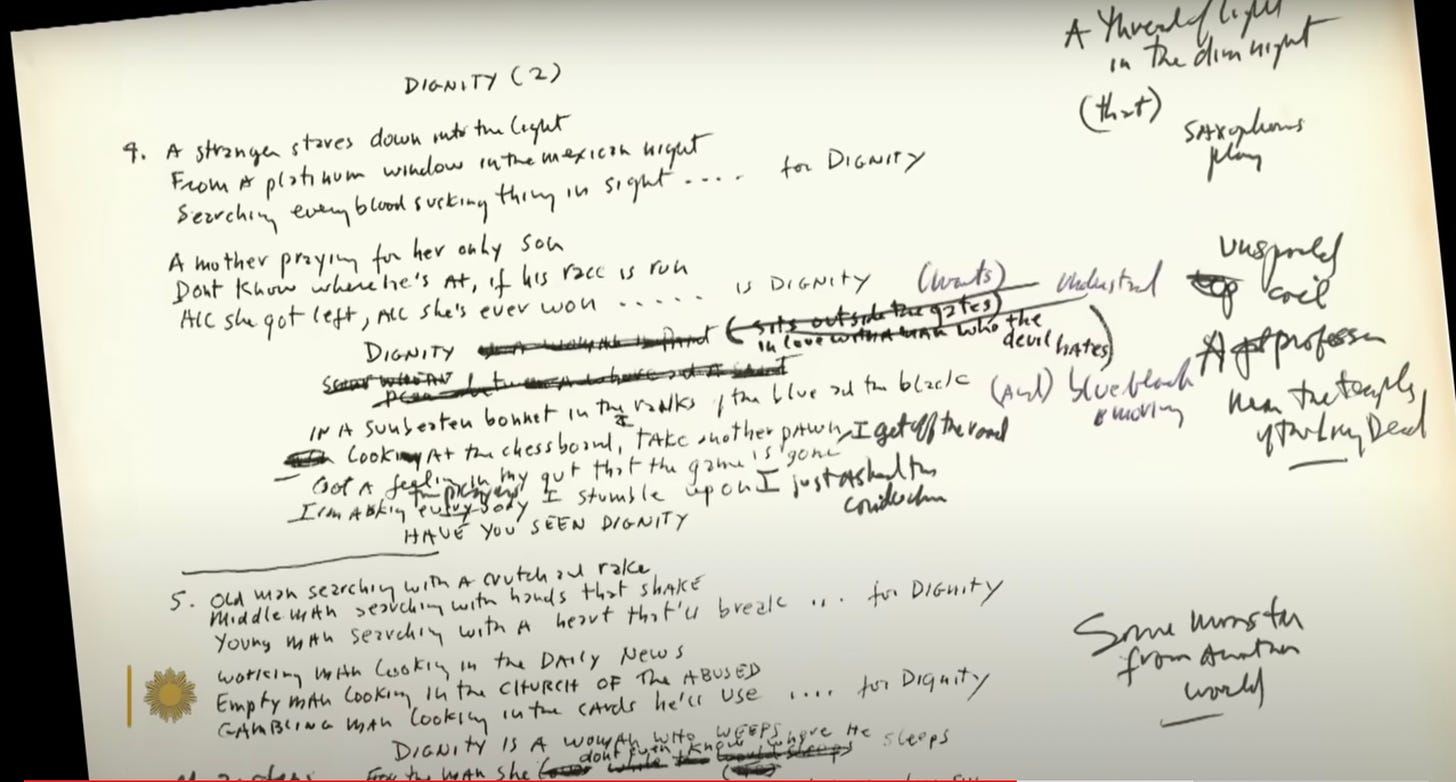
The other thing would be the temporary exhibit will change. The Archive Wall will continue to grow. I'm not sure how much with the physical artifacts in the next year, but certainly with the touch screen. And the microcinema will change out. There'll be new clips. Also I know that soon they want to do screenings of Jerry Schatzberg’s films. It will not just be Dylan content. It’ll be related to the temporary exhibition or other events that are going on in the center or in Tulsa.
Obviously, this weekend is the big event for now, but are you thinking of holding semi-regular events of any sort? Virtual, real life, etc?
Yes. I don't know too much the details about it, but there's a pretty robust education and outreach and event component. Obviously, Professor Sean Latham with the Tulsa University Institute for Bob Dylan Studies has been doing yearly events down here that will be in partnership [with us].
I'm mostly talking about the publicly available stuff, but in terms of the archives, in the sense of, you're a researcher and you get approval, will all the live audio we talked about be available in that world?
Oh, yes. 100%. In fact, Terry [Gans] listened to every minute of Infidels that was available. We had to get stuff digitized for him
So if some reason, you're like, “I want to listen to every show you have from 1999” and you're a researcher…
Sure. All that is available.
There's also, you were asking about cool discoveries. Some of the ‘78 stuff, he’s working up new songs at soundcheck. There's a great one called “This Away, That Away.” It’s just like tacked on. They use like five minutes of the tape to get some ideas down at the soundcheck, and then you get the show.
Then those songs just vanish into the ether sometimes.
They totally did. Definitely. Songs that come in and then, poof. [But] every time he's going in there, they're recording it.
Maybe it just speaks my ignorance about this technology, but I would've figured that, back before things were digital, you get your mobile truck out for a show or two and then don't do it otherwise because it's expensive and hard.
The thing is, a lot of the time they'd record on reel-to-reel, but then they'd dump it down to cassette. Reels were such a commodity and cassettes were cheaper and nobody knew that however many years later we'd be sitting here talking about this. [laughs] But the fact that it exists at all is the coup.
Do you collect audience tapes that, in most cases, probably circulate among fans already? Are you monitoring that stuff?
That's one of the things where we job it out to the collectors. They do such wonderful, thorough work in many cases that we're able to piggyback off that.
Do you even keep copies?
Sure. There's a lot of copies of audience recordings in the archive. But I wouldn't say it's an active part of the collecting.
As you say, it's already been collected.
Exactly. Somebody who's done it all and has it all organized is going to decide that they want to donate it. Again, it's not for us to decide what people are going to be interested in. No one was studying what fans were into 20 years ago, but now fan-generated stuff is an important thing.
Is it safe to assume you would still be interested if someone reading this thinks they have something amazing that maybe you don't have?
Oh, yes. They should definitely be in touch with the Archive. We're all in the service of this larger project of trying to create as complete a record as possible. Because it doesn't feel superfluous. It all adds depth and nuance. Nothing ever happens the same way twice in Dylan's music.
Thanks to Larry Jenkins for inviting me, Mark Satlof for making the connection, and most of all Parker Fishel for taking the time to talk! The Bob Dylan Center opens to the public tomorrow and is well worth a trip to Tulsa.
PS. If you’ve made it this far and don’t already subscribe, you should. Here’s a look at what’s run recently — some free, some (with locks) only for paid subscribers:

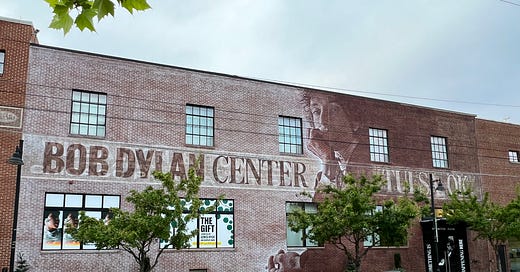



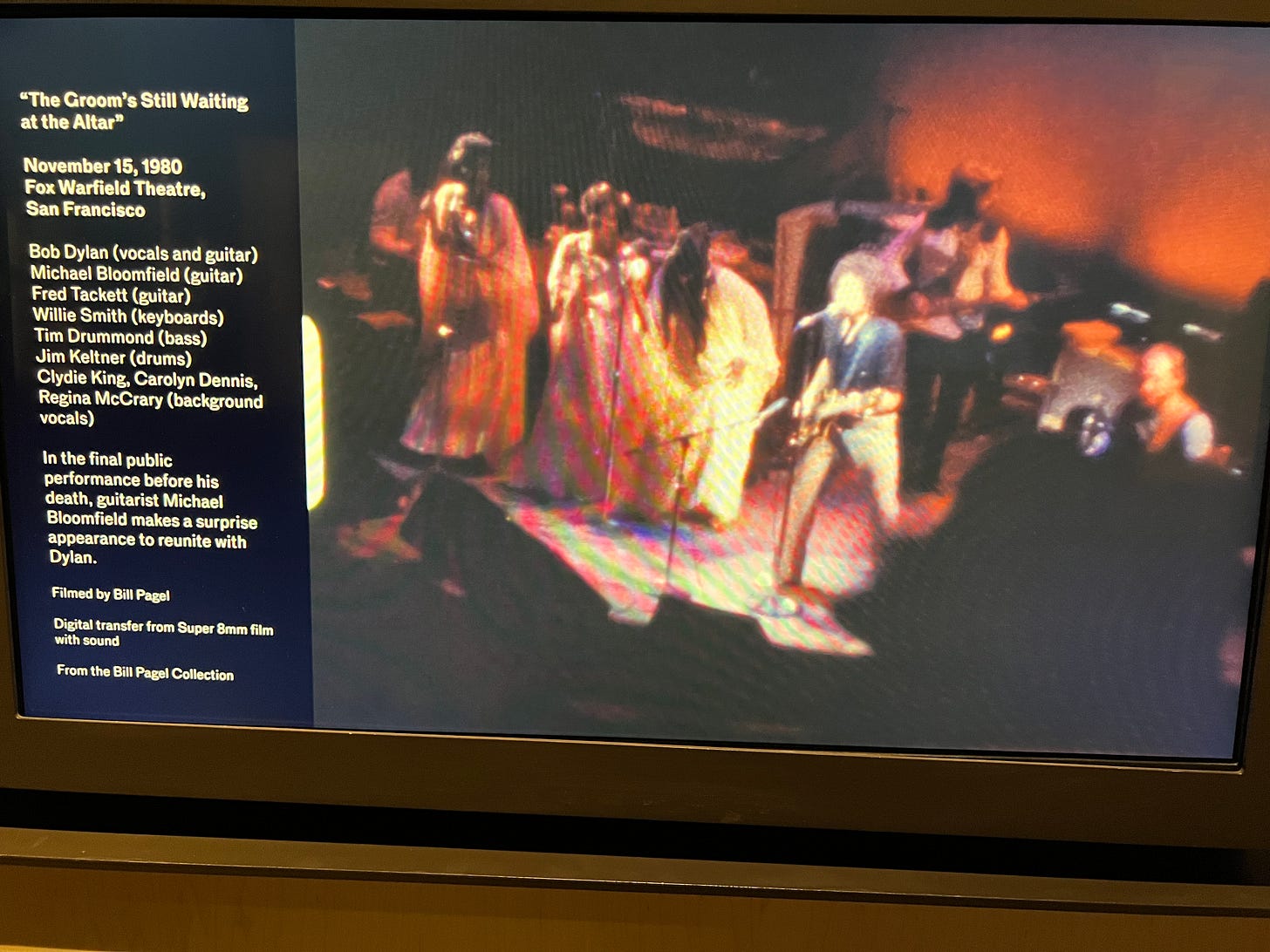
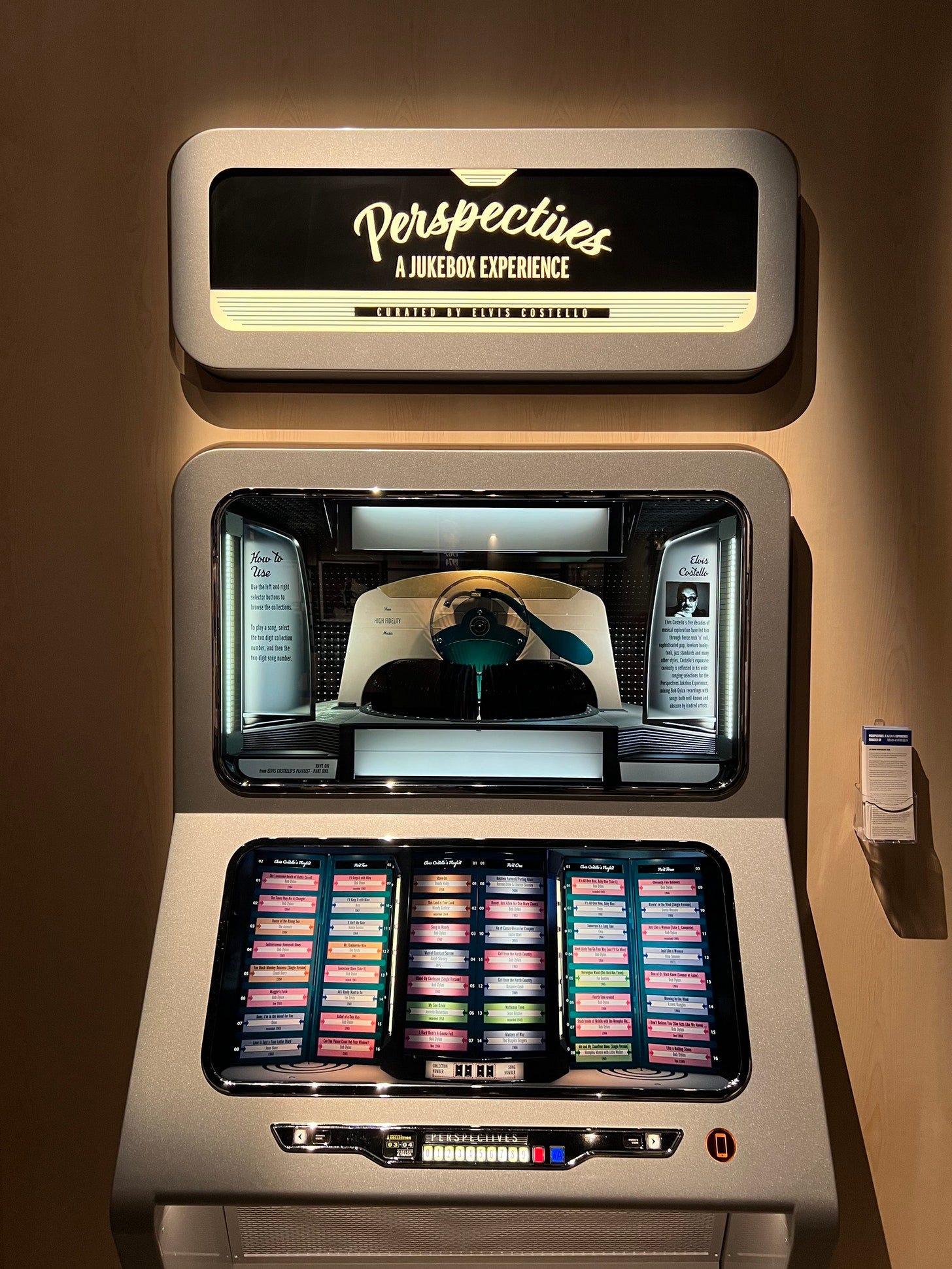
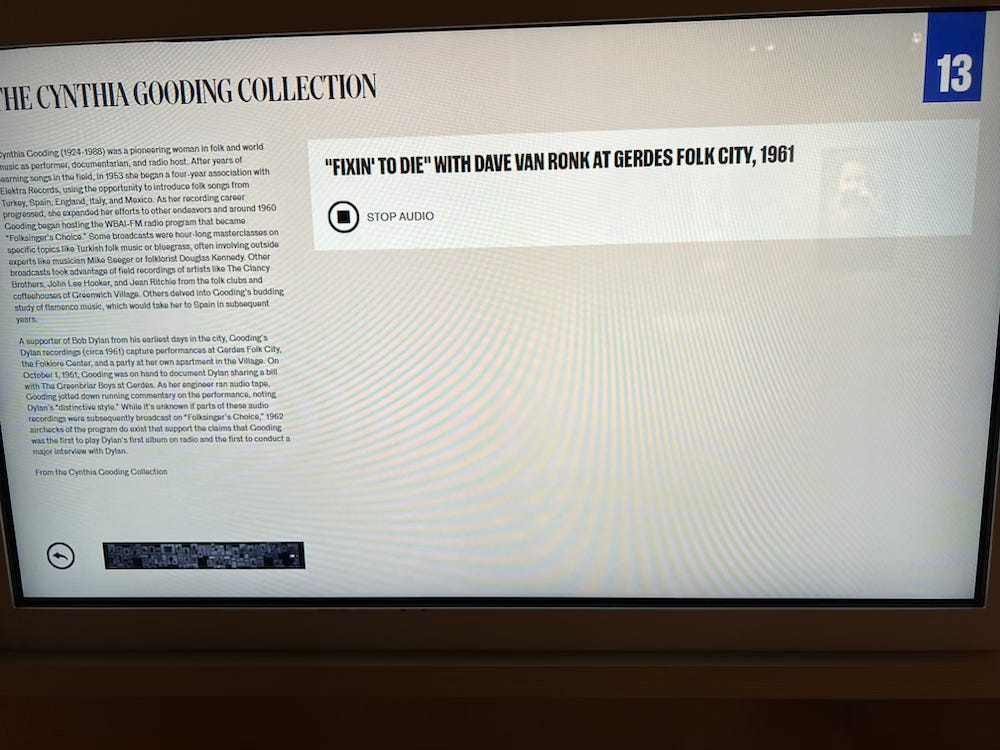

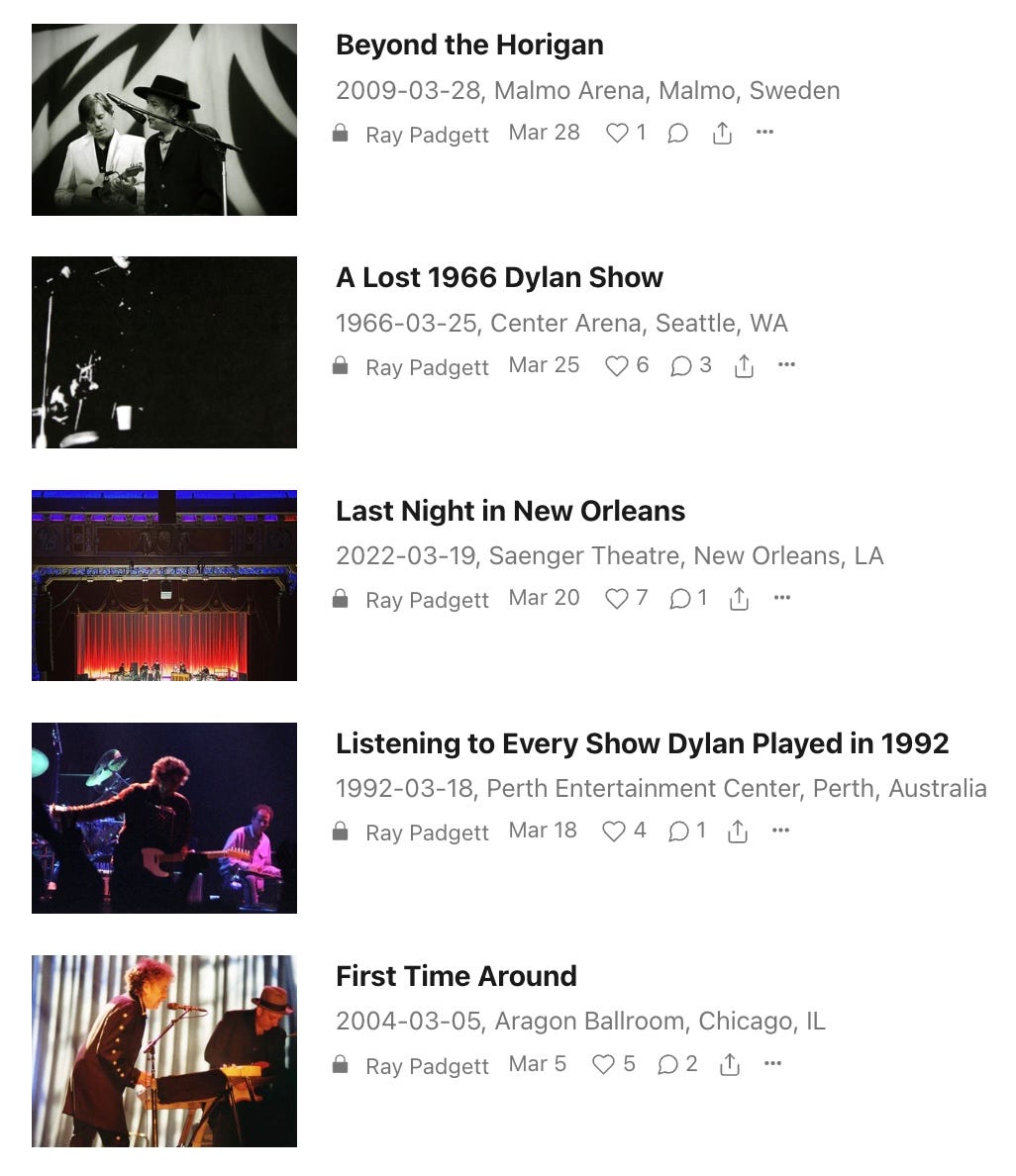
Another masterclass Ray. You asked all the questions I would have wanted to as always. Thanks for the great post and thanks to Parker too for his insight.
Ray, this was a fascinating interview. You’re right no matter how arcane your question your man Parker had a great answer. Thank you for making that connection and sharing it with us!